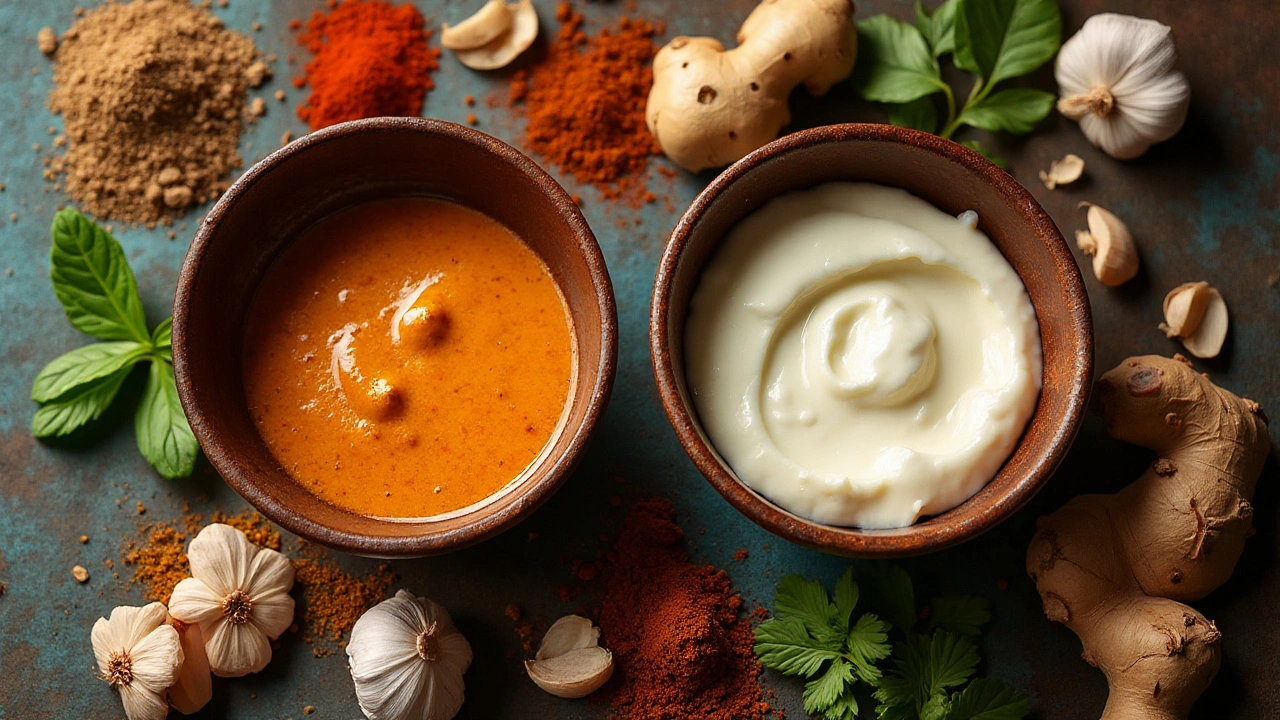When it comes to crafting the perfect tandoori chicken, the marinade is a crucial component. Traditionally, Greek yogurt is a star ingredient that not only tenderizes the meat but also adds a distinctive tangy flavor. But what if you find yourself out of Greek yogurt? Enter sour cream, a potential game-changer in the kitchen.
Sour cream, with its rich and creamy texture, can substitute Greek yogurt in the marinade, bringing its unique qualities to the dish. While it shares the creaminess, it introduces a depth that might surprise you. The results? Well, that's the culinary adventure we're about to dive into. Stay tuned as we explore this exciting replacement and see how it fares in the realm of spices and flavors.
- The Role of Yogurt in Tandoori Chicken
- What Happens When You Swap Greek Yogurt with Sour Cream
- Taste and Texture: Comparing Outcomes
- Health Considerations and Nutritional Differences
- Tips for Marinating with Sour Cream
- Final Thoughts: Choosing Your Marinade
The Role of Yogurt in Tandoori Chicken
Ah, the magic of a tandoori marinade! Yogurt is much more than a mere ingredient in this culinary masterpiece; it’s a true hero that transforms the texture and flavors of the chicken. In the case of tandoori chicken, Greek yogurt's thick consistency clings beautifully to the meat, ensuring that every bite is infused with the marinade's robust spices. This tangy dairy product acts as a tenderizer, thanks to its lactic acid content. This acid gently breaks down proteins, resulting in succulent, juicy chicken that melts in your mouth.
The emulsifying properties of yogurt help it to bind spices and flavors within the marinade, enabling them to penetrate the chicken more deeply. As a result, the finished dish offers an explosion of taste with each mouthful. It’s fascinating how such a simple ingredient can alter the culinary dynamics so profoundly. But beyond its functional merits, yogurt imparts a signature tanginess that offsets the spiciness characteristic of tandoori chicken. This balance of flavors makes it not just palatable but irresistibly tantalizing.
Historically, yogurt has roots deeply entwined with Indian cooking traditions. Ancient cultures recognized its power to enhance dishes by adding creaminess and moisture. Some culinary historians suggest that yogurt-based marinades have been used in the Indian subcontinent for hundreds, if not thousands, of years. As working individuals, we sometimes need a quick, reliable way to elevate everyday meals
"Yogurt has been known to elevate not only the taste but the nutritional value of dishes, providing both flavor and probiotics." - Culinary Historian Sarah Fox
It’s enticing to consider the health benefits that accompany yogurt’s involvement in cooking. High in protein and probiotics, it doesn’t just nourish the soul but promotes a healthy gut too. Next time you are crafting your tandoori masterpiece, remember the important role yogurt plays—not just as an ingredient, but as an enhancer of flavors and textures, wielding the power to transform a simple dish into a symphony of taste.
What Happens When You Swap Greek Yogurt with Sour Cream
Sour cream in a tandoori marinade might seem unconventional, but it's becoming a popular twist for those who wish to experiment. The change is subtle yet transformative, crafting nuances in taste and texture that can redefine your experience of traditional tandoori. Starting with its texture, sour cream is notably thicker and often richer than Greek yogurt. This attribute translates into a marinade that clings to the chicken more avidly, promising an even coating which can lead to a flavor burst in every bite.
On the taste front, sour cream offers its signature tanginess, similar to Greek yogurt but with a creamier finish. This richness introduces a new dimension of flavor, allowing the spices to meld differently. The interaction of sour cream with spices such as cumin, coriander, and turmeric can bring out deeper, often unexpected aromas, amplifying the overall sensory experience of the tandoori chicken. An interesting point to consider is how this swap affects the cooking process. Sour cream, with its fat content, can sometimes speed up the browning of the tandoori on the grill, so time adjustments might be necessary.
While the base marinade changes, the essence of the tandoori chicken remains. It's worth mentioning a culinary insight from renowned chef Vivek Singh, who once noted, "Cooking is about balancing the traditional with the novel, allowing each ingredient to tell its story."
This perspective is mirrored in every experiment with sour cream as it redefines a classic dish without departing from its roots.
Substituting sour cream also prompts a conversation about dietary diversification. Greek yogurt is known for its high protein content, which may be lost in the transition to sour cream. However, some might prefer sour cream's fat content for succulent tenderness, particularly if health considerations are secondary. Despite these changes, it's crucial to pay attention to your marination time, flavor absorption remains key. Generally, allowing the chicken to marinate overnight ensures an immersive flavor experience, whichever you choose.
Texture and Cooking Tips
The initial palpable difference in consistency affects how spices adhere and interact, compelling cooks to adapt their approach slightly. To optimize marination with sour cream, ensure that the cream is evenly mixed with spices before applying it to the chicken. A successful marinade not only covers but infuses the chicken thoroughly, creating the hallmark depth of flavor. While grilling, aim for a medium heat to allow both the marinade to crust tenderly and the chicken to cook evenly within. These minor adjustments are often the key to replicating the tender yet flavorful profile that one craves in tandoori.

Taste and Texture: Comparing Outcomes
Embarking on a culinary adventure with tandoori chicken means swimming into an ocean of vibrant flavors and tantalizing aromas. The choice between sour cream and Greek yogurt as a marinade base shapes the taste and texture in delightful, yet differing ways. Both are dairy-based, offering a creamy foundation, but they come with their own unique personalities. Greek yogurt is celebrated for its thick and tangy flavor profile, creating a robust canvas for spices to dance across. The thick consistency helps the marinade cling to the chicken, ensuring that each mouthful is a burst of flavor.
In comparison, sour cream boasts a milder tanginess complemented by a richer, slightly creamier texture. This difference can lead to a subtler flavoring in the final dish, letting the spices take center stage with a touch less tang poking through. Sour cream includes a higher fat content than Greek yogurt, which results in a luscious mouthfeel and slightly less acidic taste. For those who adore a rich and mellow flavor experience, sour cream offers this decadence, enveloping juicy chicken with a sumptuous, velvety marinade. Such richness can heighten the experience of the moderate Indian spices typical of a tandoori chicken.
Interestingly, dieticians frequently weigh in on ingredient swaps like these, offering new insights into how flavor and health interact. "The use of sour cream in cooking not only adjusts mouthfeel but can introduce a pleasing creaminess that transforms traditional recipes," suggests renowned chef Anjum Anand. Opting for sour cream over yogurt might appeal to home chefs looking to innovate with classic cuisine or avoid the sharpness some find in the latter. This swap can also have a notable effect on the caramelization process as the chicken grills, with sour cream contributing to a lovely char that crisps up while retaining moisture within.
The culinary science behind the marinade transformation is intriguing as well. The process involves acids that tenderize the meat. Sour cream and Greek yogurt employ their lactic acidosis to this end, but with sour cream, the subtler acidity might require slightly longer marination time to achieve similar tenderness. This potential difference suggests that planning is key when substituting ingredients. A simple adjustment like marinating overnight can yield the desired fork-tender results with sour cream, adapting to its gentle acid profile while exploiting its creamy richness to elevate the dish’s luxury.
Making an Informed Choice
When choosing between sour cream and Greek yogurt, it’s important to consider the specific taste and texture you’re aiming to achieve with your tandoori chicken. If the objective is the traditional tang blended seamlessly with potent spices, Greek yogurt remains an outstanding choice. However, if a creamier and richer flavor profile with mellow undertones is more enticing, sour cream could be the exciting path less traveled. Regardless of choice, it’s a delicious journey worth undertaking. As you experiment, remember to note how each variation suits your personal palate and the occasion, allowing you to craft a dish that is distinctively yours, while honoring the soulful heart of tandoori chicken.
Health Considerations and Nutritional Differences
When selecting between sour cream and Greek yogurt as a marinade for your tandoori chicken, understanding their nutritional profiles can guide your choice based on health goals or dietary preferences. Both ingredients offer distinct benefits and considerations, primarily because they derive from milk but undergo different processes. Greek yogurt is famed for its high protein content, which is a result of its straining process. The protein in Greek yogurt not only supports muscle health but also contributes to a feeling of fullness, potentially aiding in weight management.
On the other hand, sour cream is cherished for its rich and luxurious texture, yet it tends to contain higher levels of fat, particularly saturated fat, which can be a concern for those conscious about cardiovascular health. While this fat content contributes to the creamy mouthfeel and enhanced flavor of the marinade, moderation is vital. A serving of sour cream contains fewer proteins compared to Greek yogurt, which may impact its role in a protein-rich diet.
Fat content also influences the caloric value of your marinade. For those counting calories, using Greek yogurt may be more aligned with caloric restrictions. Sour cream, when used in moderation, can certainly add desired richness without overwhelming the dish, especially when balanced with the spices in tandoori chicken. “Both choices have their place in the kitchen, but it’s about knowing what you want to achieve,” says a renowned chef in culinary health studies.
One’s priority should dictate the choice here, be it texture, flavor, or nutritional content,” she adds.
For individuals with lactose intolerance, it’s worth noting that both options contain varying degrees of lactose. Greek yogurt often contains live cultures that aid in digesting lactose, potentially making it easier on the stomach. Meanwhile, sour cream might be problematic without those active cultures. Incorporating either ingredient without side effects is possible through lactose-free options now widely available.
Tandoori chicken enthusiasts will also find that the choice between sour cream and Greek yogurt may affect dietary preferences, such as vegetarianism or a low-carb diet. Both are compatible with vegetarian diets, but only Greek yogurt aligns well with low-carb preferences because of its reduced carb content through straining. Such nutritional differences prompt many home cooks and chefs to look at the broader picture of diet rather than focusing on one dish alone. Ultimately, whichever you choose should align not just with your health goals, but also with the integrity and taste profile you wish to achieve in your culinary creations.
| Nutrient | Sour Cream (per 100g) | Greek Yogurt (per 100g) |
|---|---|---|
| Calories | 214 | 59 |
| Protein | 2.0g | 10g |
| Fat | 20g | 0.4g |
| Carbohydrates | 4.6g | 3.6g |

Tips for Marinating with Sour Cream
Using sour cream as a marinade base for tandoori chicken is an alluring choice for food enthusiasts keen on experimenting with flavors. When integrating sour cream, consider its distinct tanginess and smooth texture, which can be both a boon and a challenge in achieving the desired taste profile. Begin by selecting a high-quality sour cream; options with a higher fat content tend to yield a creamier marinade, clinging better to the chicken and enriching the spices with their natural oils.
To make an effective marinade, balance is paramount. For every cup of sour cream, incorporate generous portions of classic tandoori spices like cumin, coriander, garam masala, and smoked paprika. The strong flavors of these spices counter sour cream’s inherent sweetness, ensuring a complex flavor tapestry. Consider including minced garlic and ginger paste, which lend a spicy undertone that's characteristic of traditional tandoori dishes. It's fascinating how sour cream can soften the spices, creating an appealing palate interplay.
In experimenting with tandoori chicken, patience is indeed a virtue. Allow the chicken ample time to marinate, ideally overnight, to ensure the sour cream deeply penetrates the flesh, enhancing tenderness and flavor. This indulgence in marination will not only tenderize the meat but also infuse it with a perfume of spices that wafts out invitingly during cooking. An interesting fact to note is that, historically, marinades have been used not just for flavor but as a means to preserve meats in the absence of refrigeration. This long-standing process elevates not only taste but also texture.
"Sour cream offers a delightful creaminess that, when melded with the right spices, can transform a dish completely," says culinary expert Maya Sharma. "It's about more than just taste; it's the way the marinade envelops the chicken, making each bite succulent and flavorful."
When cooking, whether by grilling or roasting, maintain a watchful eye. Sour cream tends to produce a lovely char, courtesy of its sugar content, but it can quickly over-brown if not minded. Moderate temperatures are ideal, coaxing out the flavors without compromising the creaminess. An efficient marination mixing strategy involves whisking the sour cream with the spice blend separately before introducing the chicken. This method ensures an even distribution of flavors, drawing every bit of essence into the protein efficiently.
Sour cream marinade can occasionally be a bit thicker than other bases. To adjust consistency without altering flavor significantly, a splash of lemon juice or a drizzle of olive oil can be incorporated. Lemon juice, in particular, not only thins the marinade but also complements sour cream’s tang with an acidic zest, further enhancing the chicken’s taste profile. Remember, the idea is to play with component ratios until you find the perfect balance that sings to your taste buds.
Final Thoughts: Choosing Your Marinade
Deciding between sour cream and Greek yogurt as the base for your tandoori chicken marinade can feel a bit like choosing between two old friends. Both offer distinct advantages that cater to different palates and preferences. Greek yogurt, with its origins deeply rooted in traditional Indian cuisine, is known for its thick consistency, which clings beautifully to chicken, enveloping it in a tangy embrace. It's packed with probiotics and has a slight edge when it comes to tanginess, offering that quintessential tandoori flavor that many have come to love.
On the other hand, sour cream, often hailed for its rich, luxurious texture, provides a slightly more mellow creaminess. It's an excellent option if you're looking to add some richness to your dish. Despite being a tad less tangy than Greek yogurt, sour cream's smoothness can lend a unique twist to your marinade, creating a gentle balance between spices and base. According to Chef Vikram Sunderam, "A marinade is more than just its base, it's about how it complements the spices and the chicken itself." Some home cooks find that sour cream rounds off the spices gracefully, making each bite of the chicken feel indulgently rich.
While choosing the right base comes down to personal preference, various factors like dietary needs and availability also play a role. Greek yogurt is notably higher in protein and lower in fat compared to sour cream, which might appeal to those keeping an eye on their nutritional intake. In contrast, sour cream, although richer, is lower in carbohydrates, which can be an interesting fact for those monitoring their carb consumption. The table below provides a comparison to help weigh some nutritional aspects:
| Nutrient | Greek Yogurt (100g) | Sour Cream (100g) |
|---|---|---|
| Protein | 10g | 2g |
| Fat | 3g | 20g |
| Calories | 59 | 193 |
Whichever you choose, the essence of a great tandoori chicken lies in the harmony between the chosen base and the spices. Tandoori's colorful spices—coriander, cumin, garam masala, and smoked paprika—sing their song over a creamy stage. Don't hesitate to experiment; maybe add a dash of lemon juice or a sprinkle of mustard seeds to create your unique blend. At the end of the day, both sour cream and Greek yogurt have their unique charm. As you embark on the delightful journey of making tandoori chicken, remember to enjoy the process just as much as the finished dish. It's all about personalizing it to create a masterpiece that's uniquely your own!
